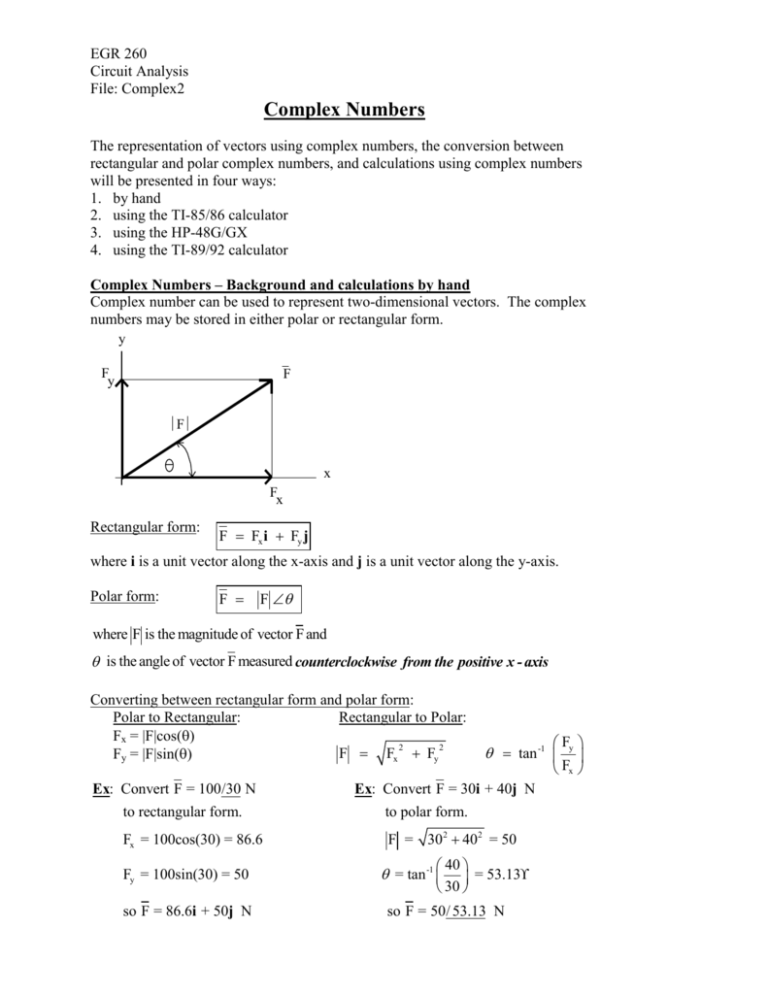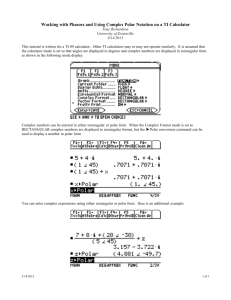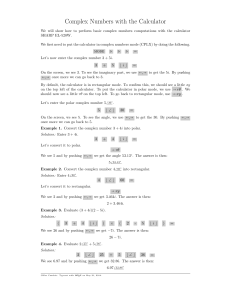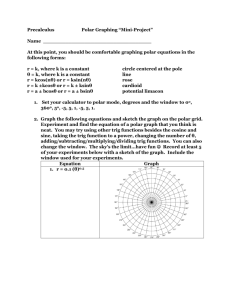Complex Numbers using TI Calculators
advertisement

EGR 260 Circuit Analysis File: Complex2 Complex Numbers The representation of vectors using complex numbers, the conversion between rectangular and polar complex numbers, and calculations using complex numbers will be presented in four ways: 1. by hand 2. using the TI-85/86 calculator 3. using the HP-48G/GX 4. using the TI-89/92 calculator Complex Numbers – Background and calculations by hand Complex number can be used to represent two-dimensional vectors. The complex numbers may be stored in either polar or rectangular form. y F y F F x F x Rectangular form: F = Fx i + Fy j where i is a unit vector along the x-axis and j is a unit vector along the y-axis. Polar form: F = F ∠θ where F is the magnitude of vector F and θ is the angle of vector F measured counterclockwise from the positive x - axis Converting between rectangular form and polar form: Polar to Rectangular: Rectangular to Polar: Fx = |F|cos(θ) 2 2 F = Fx + Fy Fy = |F|sin(θ) Ex: Convert F = 100/30 N to rectangular form. Fx = 100cos(30) = 86.6 Fy = 100sin(30) = 50 so F = 86.6i + 50j N F θ = tan -1 y Fx Ex: Convert F = 30i + 40j N to polar form. F = 30 2 + 402 = 50 40 θ = tan -1 = 53.13° 30 so F = 50/ 53.13 N Complex Numbers using the TI-85 or TI-86 Be sure that the calculator is in degree mode (press 2nd – MODE to change the mode). Complex numbers are stored as follows: (100/ 30) represents the polar number 100/30 (30,40) represents the rectangular number 30i + 40j There are two ways to convert between complex number forms: A) Using mode: If the calculator is in rectangular mode then the following conversion can be made (100/ 30) Enter (the value entered in polar form) (86.6,50) (the result in rectangular form) If the calculator is in polar mode then the following conversion can be made (30,40) Enter (the value entered in rectangular form) (50/ 53.13) (the result in polar form) B) Using the →POL and →REC functions under the CPLX menu: (This method works in any mode.) (100/ 30) (the value entered in polar form) nd 2 CPLX →REC Enter (86.6,50) (the result in rectangular form) (30,40) 2nd CPLX →POL Enter (50/ 53.13) (the value entered in rectangular form) (the result in polar form) Using variables to store complex numbers with the TI-85/86: Variables can be used to store complex numbers in either form. For example: (100/ 30) STO→ A (30,40) STO→ B A+B Enter (147.3/ 37.66) (store this polar number as variable A) (store this rectangular number as B) (the result is in whatever form is specified by the mode) Performing calculations using complex numbers with the TI-85/86: Calculations can be performed using any combination of real and complex numbers (in any form). It is generally recommended that the calculator be kept in degree mode for angles and in polar mode for complex numbers for performing AC circuit calculations. Example: Find the phasor voltage V shown in the circuit below. 25 -j80 + j20 150 o 30 V Volts 50 _ 50 + j 20 V = 150∠30° 50 + j 20 + 25 − j80 Using voltage division, Solving this equation using the calculator yields: (150/ 30)*(50,20)/((50,20) + (25,-80)) Enter (84.1/ 90.46) (Note: degree mode and polar mode used on the calculator) Complex Numbers using the HP-48G or HP-48GX Be sure that the calculator is in degree mode (use MODES to change the mode). Complex numbers are stored as follows: (100/ 30) represents the polar number 100/30 (30,40) or (30 40) represents the rectangular number 30i + 40j There are two ways to convert between complex number forms: A) Using mode: If the calculator is in rectangular mode then the following conversion can be made (100/ 30) Enter (the value entered in polar form) (86.6 50) (the result in rectangular form) If the calculator is in polar mode then the following conversion can be made (30 40) Enter (the value entered in rectangular form) (50/ 53.13) (the result in polar form) C) Using the RIGHT SHIFT POL to toggle between modes (100/ 30) (the value entered in polar form) RIGHT SHIFT POLAR (86.6 50) (the result has been toggled to rectangular form) RIGHT SHIFT POLAR (100/ 30) (the result has been toggled back to polar form) Using variables to store complex numbers with the HP-48G/GX: Variables can be used to store complex numbers in either form. For example: (100/ 30) α A STO (30 40) α B STO (store this polar number as variable A) (store this rectangular number as B) (NOW A and B can be added as follows) α A Enter α B + (147.3/ 37.66) (the result is in whatever form is specified by the mode) Performing calculations using complex numbers with the HP-48G/HP-48GX: Calculations can be performed using any combination of real and complex numbers (in any form). It is generally recommended that the calculator be kept in degree mode for angles and in polar mode for complex numbers for performing AC circuit calculations. Example: Find the phasor voltage V shown in the circuit below. 25 -j80 + j20 150 o 30 V Volts 50 _ 50 + j 20 V = 150∠30° 50 + j 20 + 25 − j80 Using voltage division, Solving this equation using the calculator yields: (50 20) Enter (25 -80) + x-1 (50 20) * (150/ 30) * (84.1/ 90.46) (Note: find the inverse of the denominator) (Note: degree mode and polar mode used on the calculator) Complex Numbers using the TI-89/92 Be sure that the calculator is in degree mode (press MODE to change the mode). Complex numbers are stored as follows: (100/ 30) represents the polar number 100/30 30 + 40i represents the rectangular number 30i + 40j There are two ways to convert between complex number forms: A) Using mode: If the calculator is in rectangular mode then the following conversion can be made (100/ 30) Enter (the value entered in polar form) 86.6 + 50i (the result in rectangular form) If the calculator is in polar mode then the following conversion can be made 30 + 40i Enter (the value entered in rectangular form) (50/ 53.13) (the result in polar form) D) Using the →Polar and →Rect functions under CATALOG: (This method works in any mode.) (100/ 30) (the value entered in polar form) CATALOG →Rect Enter 86.6 + 50i (the result in rectangular form) 30 + 40i CATAlOG →Polar Enter (50/ 53.13) (the value entered in rectangular form) (the result in polar form) Using variables to store complex numbers with the TI-89: Variables can be used to store complex numbers in either form. For example: (100/ 30) STO alpha a 30 + 40i STO alpha b a+b Enter (147.3/ 37.66) (store this polar number as variable a) (store this rectangular number as b) (the result is in whatever form is specified by the mode) Performing calculations using complex numbers with the TI-89/92: Calculations can be performed using any combination of real and complex numbers (in any form). It is generally recommended that the calculator be kept in degree mode for angles and in polar mode for complex numbers for performing AC circuit calculations. Example: Find the phasor voltage V shown in the circuit below. 25 -j80 + j20 150 o 30 V Volts 50 _ 50 + j 20 V = 150∠30° 50 + j 20 + 25 − j80 Using voltage division, Solving this equation using the calculator yields: (150/ 30)*(50 + 20i)/(50 + 20i + 25 –80i) Enter (84.1/ 90.46) (Note: degree mode and polar mode used on the calculator)







